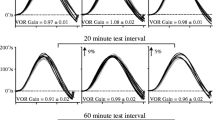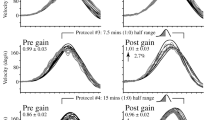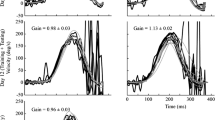Abstract
The vestibulo-ocular reflex (VOR) maintains stable vision during rapid head rotations by rotating the eyes in the opposite direction to the head. The latency between onset of the head rotation and onset of the eye rotation is 5–8 ms in healthy humans. However, VOR latency can be 3–4 times larger in patients treated with intra-tympanic gentamicin. A prior study showed that latency can be trained with head rotations at 0.2 Hz. We sought to determine how the VOR is affected when a delay between vestibular and visual stimuli is added during adaptation training with high-frequency head rotations (impulses), where the VOR is the main vision-stabilizing system. Using a variant of the incremental VOR adaptation technique, the delay between head rotation onset and movement onset of a visual target was gradually increased. With this training, the instantaneous VOR gain demand (= target/head velocity) varied from less than unity to greater than unity during each head impulse, albeit in a consistent and repeatable way. We measured the active and passive VOR gain and latency before and after VOR adaptation training in healthy normal subjects. There was no significant change in VOR latency across subjects; however, there was a significant decrease in VOR gain of − 6.0 ± 4.5%. These data suggest that during high-frequency head rotations delay/latency is interpreted as a changing instantaneous VOR gain demand. Although the gain demand in this study had a complex trajectory, adaptation was evident with the VOR seeming to use an average of the instantaneous gain demand.


Similar content being viewed by others
References
Aw ST, Haslwanter T, Halmagyi GM, Curthoys IS, Yavor RA, Todd MJ (1996) Three-dimensional vector analysis of the human vestibuloocular reflex in response to high-acceleration head rotations. I. Responses in normal subjects. J Neurophysiol 76(6):4009–4020
Clendaniel RA, Lasker DM, Minor LB (2001) Horizontal vestibuloocular reflex evoked by high-acceleration rotations in the squirrel monkey. IV. Responses after spectacle-induced adaptation. J Neurophysiol 86:1594–1611
Clendaniel RA, Lasker DM, Minor LB (2002) Differential adaptation of the linear and nonlinear components of the horizontal vestibuloocular reflex in squirrel monkeys. J Neurophysiol 88:3534–3540
Fadaee SB, Migliaccio AA (2016) The effect of retinal image error update rate on human vestibulo-ocular reflex gain adaptation. Exp Brain Res 234:1085–1094
Gauthier GM, Robinson DA (1975) Adaptation of human’s vestibulo-ocular reflex to magnifying glasses. Brain Res 92:331–335
Gimmon Y, Migliaccio AA, Todd CJ, Figtree WVC, Schubert MC (2018) Simultaneous and opposing horizontal VOR adaptation in humans suggests functionally independent neural circuits. J Neurophysiol 120:1496–1504
Gonshor A, Melvill Jones G (1976a) Short-term adaptive changes in the human vestibulo-ocular reflex arc. J Physiol 256:361–379
Gonshor A, Melvill Jones G (1976b) Extreme vestibulo-ocular adaptation induced by prolonged optical reversal of vision. J Physiol 256:381–414
Grossman GE, Leigh RJ, Abel LA, Lanska DJ, Thurston SE (1988) Frequency and velocity of rotational head perturbations during locomotion. Exp Brain Res 70:470–476
Halmagyi GM, Curthoys IS (1988) A clinical sign of canal paresis. Arch Neurol 45:737–739
Herdman SJ (1998) Role of vestibular adaptation in vestibular rehabilitation. Otolaryngol Head Neck Surg 119:49–54
Hübner PP, Khan SI, Migliaccio AA (2014) Velocity-selective adaptation of the horizontal and cross-axis vestibulo-ocular reflex in the mouse. Exp Brain Res 232:3035–3046
Hullar TE, Della Santina CC, Hirvonen T, Lasker DM, Carey JP, Minor LB (2005) Responses of irregularly discharging chinchilla semicircular canal vestibular-nerve afferents during high-frequency head rotations. J Neurophysiol 93:2777–2786
Körding KP, Tenenbaum JB, Shadmehr R (2007) The dynamics of memory as a consequence of optimal adaptation to a changing body. Nat Neurosci 10:779–786
Kramer PD, Shelhamer M, Zee DS (1995) Short-term adaptation of the phase of the vestibulo-ocular reflex (VOR) in normal human subjects. Exp Brain Res 106:318–326
Lasker DM, Hullar TE, Minor LB (2000) Horizontal vestibuloocular reflex evoked by high-acceleration rotations in the squirrel monkey. III. Responses after labyrinthectomy. J Neurophysiol 83:2482–2496
Lisberger SG, Miles FA, Optican LM (1983) Frequency-selective adaptation: evidence for channels in the vestibulo-ocular reflex? J Neurosci 3:1234–1244
Mahfuz MM, Schubert MC, Todd CJ, Figtree WVC, Khan SI, Migliaccio AA (2018a) The effect of visual contrast on human vestibulo-ocular reflex training. J Assoc Res Otolaryngol 19:113–122
Mahfuz MM, Schubert MC, Figtree WVC, Todd CJ, Khan SI, Migliaccio AA (2018b) Optimal human passive vestibulo-ocular reflex adaptation does not rely on passive training. J Assoc Res Otolaryngol 19:261–271
Mahfuz MM, Schubert MC, Figtree WVC, Todd CJ, Migliaccio AA (2018c) Human vestibulo-ocular reflex adaptation: consolidation time between repeated training blocks improves retention. J Assoc Res Otolaryngol 19:601–610
Mahfuz MM, Schubert MC, Figtree WVC, Todd CJ, Migliaccio AA (2018d) Human vestibulo-ocular reflex adaptation training: time beats quantity. J Assoc Res Otolaryngol 19:729–739
Meyer CH, Lasker AG, Robinson DA (1985) The upper limit of human smooth pursuit velocity. Vis Res 25:561–563
Migliaccio AA, Schubert MC (2013) Unilateral adaptation of the human angular vestibulo-ocular reflex. J Assoc Res Otolaryngol 14:29–36
Migliaccio AA, Minor LB, Carey JP (2004a) Vergence-mediated modulation of the human horizontal vestibulo-ocular reflex is eliminated by a partial peripheral gentamicin lesion. Exp Brain Res 159:92–98
Migliaccio AA, Halmagyi GM, McGarvie LA, Cremer PD (2004b) Cerebellar ataxia with bilateral vestibulopathy: description of a syndrome and its characteristic clinical sign. Brain 127(Pt 2):280–293
Migliaccio AA, Minor LB, Carey JP (2008) Vergence-mediated modulation of the human angular vestibulo-ocular reflex is unaffected by canal plugging. Exp Brain Res 186:581–587
Minor LB, Lasker DM, Backous DD, Hullar TE (1999) Horizontal vestibuloocular reflex evoked by high-acceleration rotations in the squirrel monkey. I. Normal responses. J Neurophysiol 82:1254–1270
Quinn KJ, Schmajuk N, Baker JF, Peterson BW (1992) Simulation of adaptive mechanisms in the vestibulo-ocular reflex. Biol Cybern 67:103–112
Rinaudo CN, Schubert MC, Figtree WVC, Todd CJ, Migliaccio AA (2019) Human vestibulo-ocular reflex adaptation is frequency-selective. J Neurophysiol 122:984–993
Sadeghi SG, Minor LB, Cullen KE (2006) Dynamics of the horizontal vestibuloocular reflex after unilateral labyrinthectomy: response to high frequency, high acceleration, and high velocity rotations. Exp Brain Res 175:471–484
Schubert MC, Della Santina CC, Shelhamer M (2008) Incremental angular vestibulo-ocular reflex adaptation to active head rotation. Exp Brain Res 191:435–446
Shelhamer M, Tiliket C, Roberts D, Kramer PD, Zee DS (1994) Short-term vestibulo-ocular reflex adaptation in humans. II. Error signals. Exp Brain Res 100:328–336
Skavenski AA, Robinson DA (1973) Role of abducens neurons in vestibulo-ocular reflex. J Neurophysiol 4:724–738
Straka H, Lambert FM, Pfanzelt S, Beraneck M (2009) Vestibulo-ocular signal transformation in frequency-tuned channels. Ann N Y Acad Sci 1164:37–44
Zee DS, Yamazaki A, Butler PH, Gacer G (1981) Effects of ablation of flocculns and paraflocculus on eye movements in primates. J Neurophysiol 46:878–899
Zee DS, Kramer R, Shelhamer M, Tiliket C (1994) Adaptive control of the phase of the vestibulo-ocular reflex. In: Fuchs AF, Brandt T, Btittner U, Zee DS (eds) Contemporary ocular motor and vestibular research: a tribute to David A. Robinson. Thieme, Stuttgart, pp 52–59
Acknowledgements
A. A. Migliaccio was supported by The Garnett Passe and Rodney Williams Memorial Foundation (Grant no. SPRF2014) Senior/Principal Research Fellowship in Otorhinolaryngology.
Author information
Authors and Affiliations
Corresponding author
Additional information
Communicated by Winston D Byblow.
Publisher's Note
Springer Nature remains neutral with regard to jurisdictional claims in published maps and institutional affiliations.
Rights and permissions
About this article
Cite this article
Figtree, W.V.C., Schubert, M.C., Rinaudo, C.N. et al. The instantaneous training demand drives vestibulo-ocular reflex adaptation. Exp Brain Res 238, 2965–2972 (2020). https://doi.org/10.1007/s00221-020-05953-1
Received:
Accepted:
Published:
Issue Date:
DOI: https://doi.org/10.1007/s00221-020-05953-1




